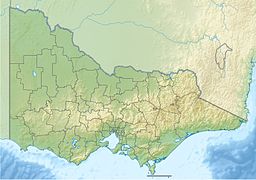Lake Hindmarsh, an ephemeral lake located in the Wimmera region of western Victoria, Australia, is the state's largest natural freshwater lake. The nearest towns are Jeparit to the south and Rainbow to the north. After more than a decade of drought, in early 2011 the lake filled as a result of flooding in the region. The Wemba Wemba name of the lake is recorded as Gour or Koor.[2][3]
| Lake Hindmarsh | |
|---|---|
| Gour (Wemba Wemba) | |
Location in Victoria | |
| Location | Wimmera, Victoria |
| Coordinates | 36°03′41″S 141°54′47″E / 36.06139°S 141.91306°E[1] |
| Type | Eutrophic |
| Primary inflows | Wimmera River |
| Primary outflows | Outlet Creek (When full), evaporation |
| Catchment area | 23,500 km2 (9,100 sq mi) |
| Basin countries | Australia |
| Max. length | 22 km (14 mi) |
| Max. width | 7 km (4.3 mi) |
| Surface area | 135 km2 (52 sq mi) |
| Average depth | 3.4 m (11 ft) |
| Max. depth | 3.65 m (12.0 ft) |
| Water volume | 378 GL (8.3×1010 imp gal; 1.00×1011 US gal) |
Geography
editLake Hindmarsh is the northernmost lake of the Wimmera River Terminal Wetlands, and receives water directly from the Wimmera River. When full, the lake covers 13,500 hectares (33,000 acres), is 3.4 metres (11 ft) deep and holds 378 gigalitres (8.3×1010 imp gal; 1.00×1011 US gal) of water.[4] It is a wetland of national significance. On the rare occasions when Lake Hindmarsh overflows, water runs, via Outlet Creek (Wergaia: Krumelak),[5] to the deeper Lake Albacutya (Wergaia: Ngelbakutya),[5] which has been recognised under the Ramsar Convention as a wetland of international importance.[6]
Flat and shallow, Lake Hindmarsh is subject to very high evaporation. When it is full, evaporation from the lake is around 140,000 megalitres (3.1×1010 imp gal; 3.7×1010 US gal) per year. With flows down the Wimmera River averaging only half of that, the lake rarely fills, but if it does, the water takes three to four years to evaporate entirely.
The lake was full during the wet years of the early to mid-1970s. It supported a commercial fishing industry and was a destination for tourism and water sports, with a water-skiing club having a membership of over 100. The lake filled again in 1996, but then received no further water from the Wimmera River, and had dried up by 2000. It remained dry for almost a decade.
In October 2009, water from the Wimmera River trickled into Lake Hindmarsh for the first time in thirteen years.[7] The 2010 Victorian floods of September raised lake water levels higher and triggered a revival of birdlife.[8] The January 2011 Victorian floods in the Wimmera catchment raised hopes that the lake would fill, and possibly overflow into the lakes to the north.[9] However, Outlet Creek remained dry.
Indigenous people
editThe area around the lake is the traditional country of the Gromiluk, a branch of the Wotjobaluk people.[10] They speak the Wergaia language.[11]
Colonial history
editExplorer Edward Eyre camped at Lake Hindmarsh in 1838 while searching for an overland route from Melbourne to Adelaide,[12] and named the lake after the then governor of South Australia, John Hindmarsh.[13] European pastoralists occupied land around the lake from 1845, and the Moravian Ebenezer Mission was established nearby in 1859.
See also
editReferences
edit- ^ "Lake Hindmarsh (entry 3581)". VICNAMES. Government of Victoria. Retrieved 4 June 2014.
- ^ "Tindale Tribes - Wotjobaluk". archives.samuseum.sa.gov.au. Retrieved 24 July 2020.
- ^ "NATIVE NAMES OF HILLS, RIVERS, LAKES, AND OTHER NATURAL FEATURES IN VICTORIA" (PDF). Archived from the original (PDF) on 5 February 2017. Retrieved 24 July 2020.
- ^ Murray-Darling Basin Authority Archived from the original Archived 2012-02-29 at WebCite 2012-02-29.
- ^ a b Griffin, Darren; Muir, Ben. "Barringgi Gadyin – The Wimmera River and Wotjobaluk Connection to Country" (PDF). biolinksalliance.org.au. Retrieved 17 October 2021.
- ^ "Significant wetlands: Lake Albacutya". Department of Environment and Primary Industries. Government of Victoria. 22 January 2014. Retrieved 4 June 2014.
- ^ Ker, Peter (9 October 2009). "Meet Lake Hindmarsh, back from the dead". The Age. Retrieved 20 September 2016.
- ^ Ker, Peter (18 September 2010). "At Lake Hindmarsh there's an ecological revolution under way". The Age. Retrieved 20 September 2016.
- ^ Ker, Peter (25 January 2011). "Parched lake may end 15-year dry". The Age. Retrieved 20 September 2016.
- ^ Biography - Nathaniel Pepper, Australian Dictionary of Biography, Retrieved 2012-02-29.
- ^ "Victorian Aboriginal Corporation for languages - Wegaia". Victorian Aboriginal Corporation for languages. Retrieved 1 June 2021.
- ^ Biography - Edward John Eyre, Australian Dictionary of Biography, Retrieved 2012-02-29.
- ^ Bull, John Wrathall (1884). Early Experiences of Life in South Australia (2nd ed.). Adelaide: E.S. Wigg & Son. Archived from the original on 8 September 2015. Retrieved 3 March 2016. see also Early Experiences of Colonial Life in South Australia
